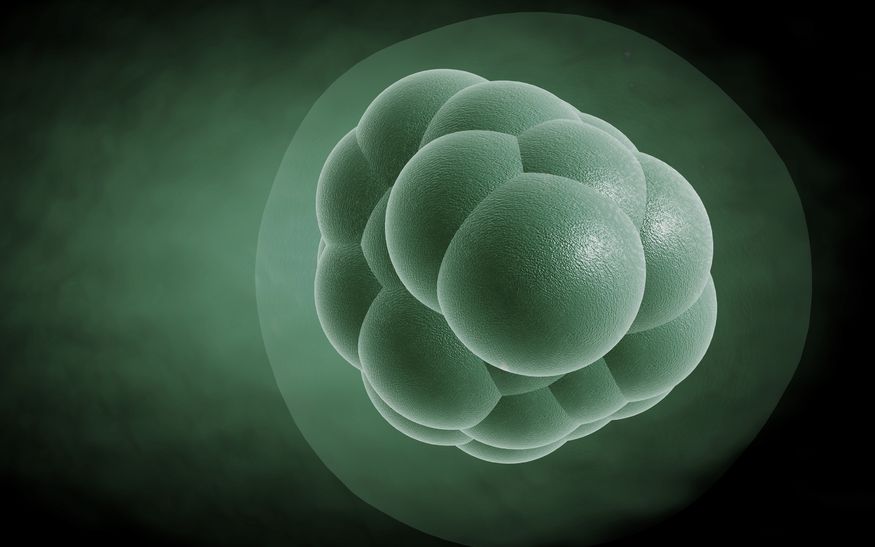
Stem cells represent a pool of unspecialized cells, remarkable for their ability to differentiate into virtually any class of cell types during the early stages of growth and development. Being limitless in the ability to reproduce themselves, they are also essential elements of internal self-repair mechanisms, replacing old or damaged cells all throughout a person’s life (Medical News Today, 2016).
Commonly, stem cells are sourced either from adult tissues (adult stem cells) or embryos (embryonic or fetal stem cells).
Embryonic Stem Cells
Embryonic stem cells are extracted from the blastocyst, an early embryonic structure formed three to five days after an egg is fertilized by sperm (Medical News Today, 2016). Under natural conditions, all tissues and eventually the entire body develop from the inner cell mass of the blastocyst. However, carefully extracted and cultivated with special laboratory equipment, these cells retain all initial properties even beyond the maternal organism.
Fetal stem cells are pluripotent, which means they can transform into any cell type found in a fully developed human body. These cells are of particular value for scientists, since they serve as a renewable substrate for drug trials and enable close monitoring of the physiological and pathological processes (Closer Look at Stem Cells, 2015).
Adult stem cells
Adult stem cells (also known as tissue-specific or somatic stem cells) differ from the embryonic stem cells in that they have already undergone some level of specialization. Typically, adult stem cells can give rise to various cell types only for a certain organ or tissue to which they belong (Medical News Today, 2016).
For instance, a hematopoietic (blood-forming) stem cell of the bone marrow can develop into either an erythrocyte, leukocyte, or platelet, but not into a muscle or liver cell. Conversely, myocytes or hepatocytes do not produce any of the components of the blood (Closer Look at Stem Cells, 2015).
Adult stem cells can be found in every organ, but they are very few in number. Generating significant quantities of these cells in laboratory settings is problematic, because their ability to reproduce beyond the living tissue is limited (Closer Look at Stem Cells, 2015). At present, scientists across the world combine their efforts to find more efficient ways of obtaining larger quantities of somatic stem cells in cell cultures, so they can be utilized for production of specific cell types and, subsequently, for treatment of a variety of illnesses.
Medical applications
There are many ways in which stem cells can be applied in research and clinical practice today, and the majority of scientists feel even more optimistic about the benefits stem cell therapy may hold for us in a close future.
Currently, stem cell cultures are extensively used in pharmacology; specialized cells derived from pluripotent cell lines provide the optimal substrate for drug safety trials. Other types of cells, such as cancer cell lines, are highly valuable when a specific therapeutic effect of a new remedy is tested (National Institute of Health, 2015).
One of the most promising fields where the use of stem cells is increasing dramatically is cell-based therapy. Currently, healthy material for replacement of damaged tissues is sourced mainly from the donated organs, but the available supply is limited and insufficient to meet the medical demand (National Institute of Health, 2015). Stem cell cultures, on the other hand, are a renewable, limitless pool of normal cells, and their unique ability to differentiate into any cell type when placed in a specific tissue makes them a revolutionary alternative to conventional transplants. Very soon, many severe diseases as diverse as stroke, diabetes, spinal cord injury, rheumatoid arthritis, cardiovascular disease, and macular degeneration may become easily curable thanks to stem cells.
Hopefully, in a not too distant future, scientists will be able to grow healthy myocardium in laboratory conditions, and millions of chronic cardiovascular patients will receive effective treatment. A recent study in mice has shown that bone marrow stromal cells, injected into the damaged cardiac tissue, can have a positive impact (National Institute of Health, 2015). To find out whether these cells induce neovascularization, produce new myocytes, or boost reparation via some other mechanism is now the aim of many investigations. For instance, transplanted cells may foster reparation indirectly, by stimulating the secretion of growth factors, or directly, by actually being incorporated into the heart muscle (National Institute of Health, 2015). Illnesses such as Alzheimer’s and Parkinson’s disease may also be treated in a similar manner—by inoculation of stem cells in the affected areas of the brain.
Ethical issues
Many, however, argue it is unethical to conduct stem cell research on animals, since such experiments give birth to chimeras—hybrids of animals and human beings (Medical News Today, 2016) Studies that involve insertion of human cells into animals enable investigators to observe anatomical characteristics of two species being blended in one organism. This provokes much outrage within the society that is barely ready to accept the moral challenge concerned with the creation of something “part human-part animal.”
References
Closer Look at Stem Cells. (2015). Types of Stem Cells. [online] Available at: http://www.closerlookatstemcells.org/learn-about-stem-cells/types-of-stem-cells [Accessed 2 Apr. 2016].
Medical News Today. (2016). What are Stem Cells?. [online] Available at: http://www.medicalnewstoday.com/info/stem_cell/ [Accessed 2 Apr. 2016].
National Institute of Health. (2015). Stem Cells Basics. [online] Available at: http://stemcells.nih.gov/info/basics/pages/basics6.aspx [Accessed 2 Apr. 2016].

